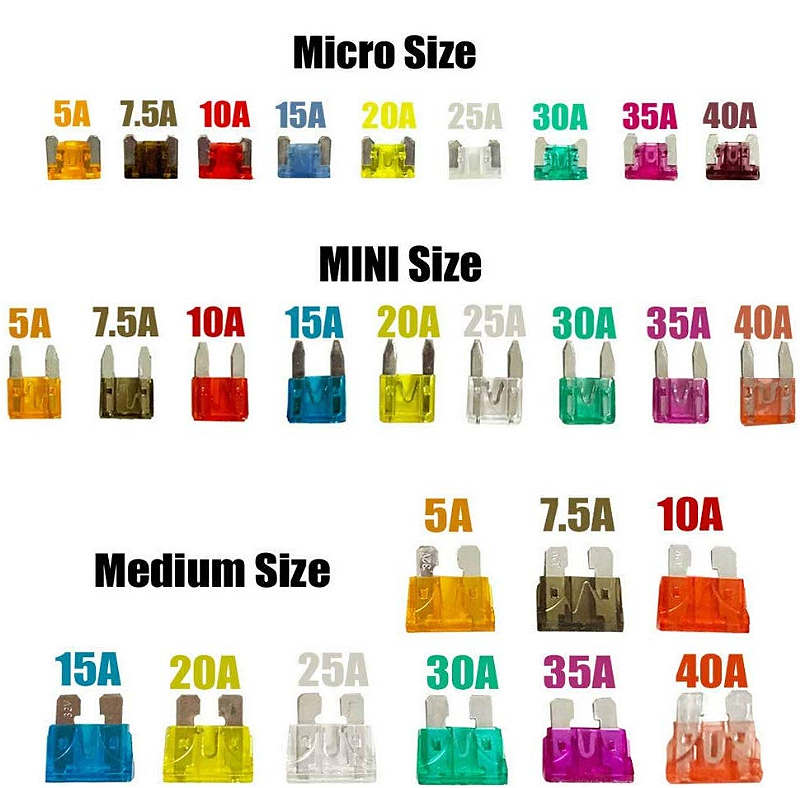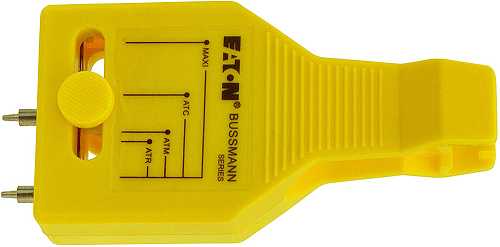Fuses protect your vehicle’s electrical system from overloading. If electrical parts in your vehicle are not working, the system may have been overloaded and blown a fuse. Before you replace or repair any electrical parts, check the appropriate fuses.
The following charts tell you which fuses protect each electrical part of your vehicle. If a fuse blows, all the parts of your vehicle that use that circuit will not work.
Once you have determined which fuses to check, follow the procedures under Checking and Replacing Fuses further down this page.
Passenger Compartment Fuse Panel
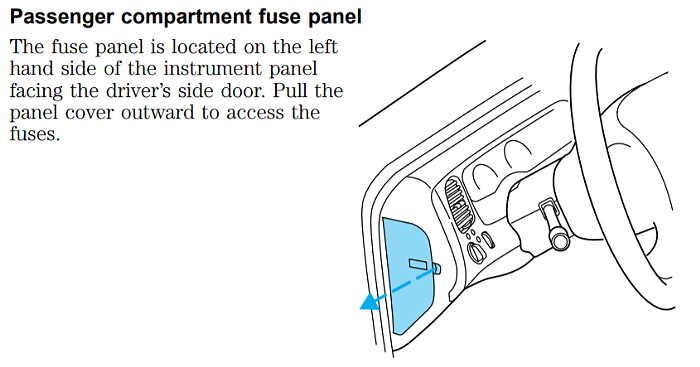
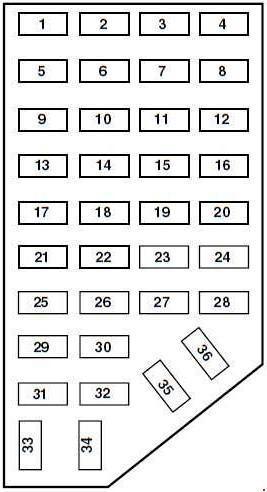
| No. | AMPS | Circuits protected |
| 1 | 7.5 | Power Mirror Switch |
| 2 | 7.5 | Blower Motor Relay, PAD Module, Air Bag Diagnostic Monitor |
| 3 | 7.5 | Left Stop/Turn Trailer Tow Connector |
| 4 | 10 | Left Headlamp |
| 5 | 10 | 1998-1999: Data Link Connector (DLC) |
| 6 | 15 | 2000: Overdrive, Back-up Lamps, DRL, 4×4 |
| 7 | 7.5 | Right Stop/Turn Trailer Tow Connector |
| 8 | 10 | Right Headlamp, Fog Lamp Relay |
| 9 | 7.5 | Brake Pedal Position Switch |
| 10 | 7.5 | Speed Control Servo/Amplifier Assembly, Generic Electronic Module (GEM), Shift Lock Actuator, Blend Door Actuator, A/C-Heater Assembly, Turn Signals |
| 11 | 7.5 | Instrument Cluster, Daytime Running Lights (DRL), RABS Resistor |
| 12 | — | Not Used |
| 13 | 20 | Brake Pedal Position Switch |
| 14 | 20 | Rear Anti-Lock Brake System (RABS) Module |
| 10 | 4 Wheel Anti-Lock Brake System (4WABS) Module, 4WABS Main Relay | |
| 15 | 7.5 | Air Bag Indicator Lamp, Alternator Indicator Lamp, Instrument Cluster |
| 16 | 30 | Windshield Wiper Motor, Wiper Hi-Lo Relay, Wiper Run/Park Relay |
| 17 | 25 | Cigar Lighter, Data Link Connector (DLC; 2000) |
| 18 | 15 | Driver’s Unlock Relay, All-Unlock Relay, All-Lock Relay |
| 19 | 25 | PCM Power Diode, Ignition, PATS |
| 20 | 7.5 | RAP Module, Generic Electronic Module (GEM), Radio |
| 21 | 15 | Flasher (Hazard) |
| 22 | 20 | Auxiliary Power Socket |
| 23 | — | Not Used |
| 24 | 7.5 | Clutch Pedal Position (CPP) switch, Starter Interrupt Relay, Anti-Theft |
| 25 | 7.5 | 1998-1999: Generic Electronic Module (GEM), Instrument Cluster |
| 26 | 10 | Battery Saver Relay, Electronic Shift Relay, Interior Lamp Relay, Power Window Relay, Electronic Shift Control Module, Dome/Map Lamp, GEM, Instrument Cluster (2000) |
| 27 | 15 | 1998-1999: Electric Shift, Backup Lamps, Daytime Running Lamps (DRL), Transmission Control Switch, Pulse Vacuum Hub Lock |
| 28 | 7.5 | Generic Electronic Module (GEM), Radio |
| 29 | 15 | Radio |
| 30 | 10 | 1999-2000: RABS Test Connector |
| 15 | 1998: Park Lamp/Trailer Tow Relay | |
| 31 | — | Not Used |
| 32 | — | Not Used |
| 33 | 15 | Headlamps, Daytime Running Lamps (DRL) Module, Instrument Cluster |
| 34 | — | Not Used |
| 35 | 15 | 1999: Park Lamp/Trailer Tow Relay |
| 10 | 1998: RABS Test Connector | |
| 36 | — | Not Used |
Power Distribution Box
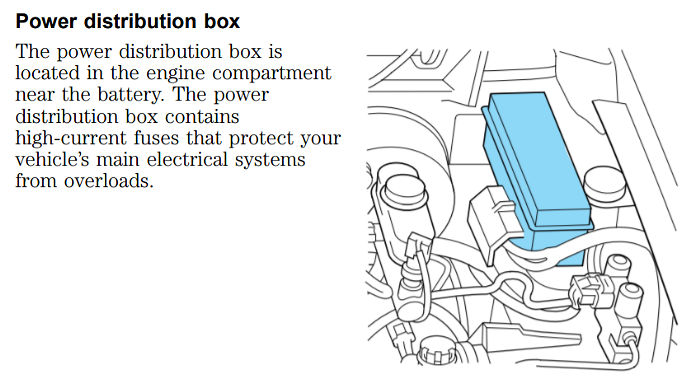
The power distribution box is located in the engine compartment on the drivers side near the fender.
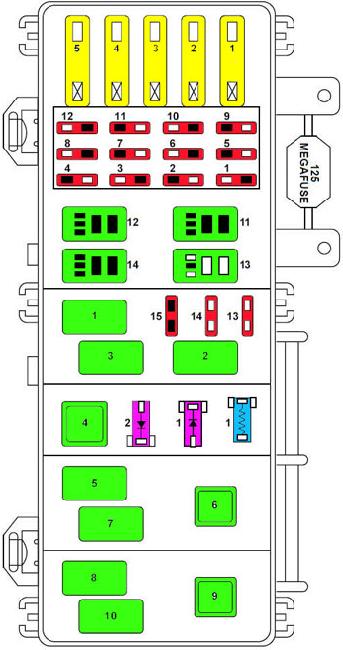
| No. | AMPS | Circuits protected |
| 1 | 50 | I/P Fuse Panel |
| 2 | 40 | Blower Motor Relay |
| 3 | 50 | 4 Wheel Anti-Lock Brake System (4WABS) Module |
| 4 | 20 | Power Windows |
| 5 | 50 | Ignition Switch, Starter Relay |
| 1 | 10 | A/C Relay |
| 2 | 20 | Auxiliary Power Point |
| 3 | 20 | Electronic Shift Relay and Electronic Shift Control Module |
| 4 | 20 | 2000: Fog Lamp and Daytime Running Lamps |
| 15 | 1998-1999: Fog Lamp and Daytime Running Lamps | |
| 5 | 15 | 2000: Trailer Tow Park Lamps |
| 10 | 1998: Air Bag Diagnostic Monitor | |
| 6 | 10 | Powertrain Control Module |
| 7 | 30 | 4 Wheel Anti-lock Brake System (4WABS) Module |
| 8 | 30 | PCM Relay |
| 9 | 20 | Fuel Pump Relay and RAP Module |
| 10 | 15 | Horn Relay |
| 11 | 15 | Parklamps Relay and Main Light Switch |
| 12 | 30 | Mam Light Switch and Multifunction Switch |
| 13 | 15 | Heated Oxygen Sensor, EGR Vacuum Regulator, EVR Solenoid, Camshaft Position Sensor (CMP), Canister Vent Solenoid |
| 14 | 30 | Alternator Voltage Regulator |
| 15 | — | Not Used |
| 1 | Wiper Park Relay | |
| 2 | A/C Relay | |
| 3 | Wiper Hi/Lo Relay | |
| 4 | PCM Power Relay | |
| 5 | Fuel Pump Relay | |
| 6 | Starter Relay | |
| 7 | Horn Relay | |
| 8 | 1999-2000: Fog Lamp Control Relay 1998: Washer Pump Relay |
|
| 9 | Blower Motor Relay | |
| 10 | 1999-2000: Foglamp Isolation Relay 1998: Foglamp Relay |
|
| 11 | Not Used | |
| 12 | Not Used | |
| 13 | Park Lamp/Trailer Tow Relay | |
| 14 | Washer Pump Relay | |
| 1 | RABS Resistor | |
| 1 | RABS Diode | |
| 2 | Electronic Engine Controls Diode | |
Checking and Replacing Fuses
If you need to check a fuse, follow these steps:
1. Find the fuse panel, which is located in the left end of the instrument panel. The power distribution box (described earlier in this section) is found in the engine compartment, mounted on a bracket attached to the drivers side fender apron.
To access the fuse panel, remove the fuse panel cover by inserting your finger in the divot and pulling on the cover. The underside of the cover contains four spare fuses. A fuse pulling tool is located in the lower right corner of the fuse panel in case you need to replace a blown fuse.
Color Coded: The spare fuses for your vehicle are color coded as follows:
- 10 amp — red
- 15 amp — light blue
- 20 amp — natural
- 30 amp — light green.
See further down on this page for examples
2. On the fuse panel cover, find the number of the fuse you want to check. The diagram on the cover tells you where to
locate the fuse on the panel.
3. Check the fuse to see if it is blown. Look through the clear side of the fuse to see if the metal wire inside is separated. If it is, the fuse is blown and should be replaced.
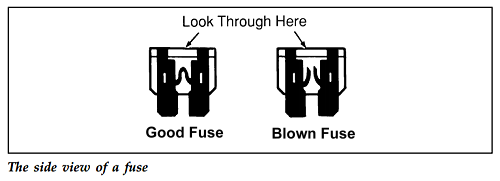
Another method for testing fuses is to use a Bussmann fuse tester. There’s no need to remove the fuse from the holder. You simply adjust the prong width on the tester to line up with the bare metal spots on the end of the fuse, and then watch for the indicator light to glow signaling that the fuse is good.
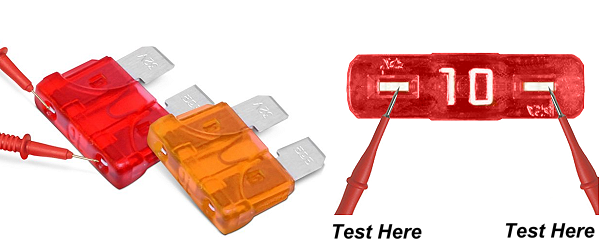
4. Replace the fuse with one that has the right amperage rating
*WARNING Always replace a fuse with one that has the specified amperage rating. Using a fuse with a higher amperage rating can cause severe wire damage and could start a fire.
5. Put the fuse panel cover back on.
Even after you replace a fuse, it will continue to blow if you do not find what caused the overload. If the fuse continues to blow, have your electrical system checked.
Fuse Color / Ratings:
As mentioned above, fuses are color coded to their AMP rating. See the image below for examples.
